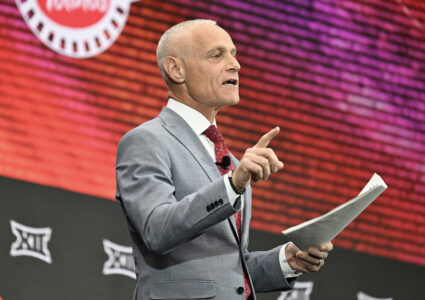Photo courtesy of the Big 12.
ARLINGTON, Texas — I appreciate people who cut out the crap and get right to the point. That’s what the Big 12’s new commissioner did during his introductory press conference on Wednesday morning in “Jerry World.”
“One thing is crystal clear,” Brett Yormark firmly stated. “There is no higher priority than to best position the Big 12 for its upcoming multimedia negotiations. Everything we do must create momentum for these negotiations, as well as the value of the Big 12 brand and business.”
Spot-freaking-on.
Talking heads can reference academics and taking care of the student-athlete. That’s all great, but why else are two schools in Southern California going to be sending their tennis programs across the country to compete in the Big Ten?
None of what’s going on makes any sense, other than the fact that we know everything is about money. No form of revenue at a conference level is more important than media rights. Nothing else is even close.
So what is in the playbook from here for the new Big 12, which is scheduled to lose giants Texas and Oklahoma in 2025 (while adding BYU, Central Florida, Cincinnati and Houston in 2023)?
Mix up your partners and maximize revenue. That’s a bit of the impression I got from new Big 12 commissioner Brett Yormark.
Yormark made it very clear that the playbook will still smartly begin with linear television. However, the words “hip and cool” were deliberately thrown around often by the former Roc Nation executive throughout the day.
So I just came out and asked him if a partnership with big tech made sense for the Big 12’s future?
“A digital platform connects us to a younger audience when you think about it from that perspective,” Yormark said. “And I think that as I look forward, we will be linear because that’s the reach factor that helps build your brand. There’s nothing like linear TV.”
Yormark has a background in the NBA with the Brooklyn Nets. He spoke often about those experiences on Wednesday.
“If you think about the six most highly rated TV shows in the month of June, there were the six NBA Finals games,” Yormark said. “What does that mean? It means there’s nothing like TV and live sports. And so we’re in a great place where the live sports business.”
But…
“I think there’s a real opportunity there to diversify between linear and digital,” Yormark said. “And we’re doing a little bit of that now, obviously, with ESPN-Plus, but do I think we can amplify that in the future? Absolutely.”
The Big 12’s current media contracts run through the year 2025.
Outgoing commissioner Bob Bowlsby offered up thoughts on this topic as well. As far as big tech goes, Bowlsby sternly said: “Your guess is as good as mine. They haven’t written very many checks so far. But the world is changing. What do you envision?”
I think we are in the top of the first inning here, Mr. Bowlsby. It’s still really early, but I promise you that the folks at Amazon and Apple are paying close attention to sports media rights going forward. I also know that they have a pile of cash lying around and will get in the game whenever they please.
Bowlsby said he believes the idea of a linear television network for the Big 12 is not a pressing concern going forward.
“Conference networks, every last one of them is getting smaller,” Bowlsby said. “There are fewer cable households today than any time in the last 15 years. And they’re going to continue to get smaller. So you know, when you think about adding the linear network, you’re adding an asset that is going to be smaller the day after the day you start so reasonable people could disagree. But that doesn’t seem to be the direction that people that the consumers are going.”
“The Big 12 is open for business,” Yormark said.
That appears to be the case with expansion, as he noted that the Big 12 has created a committee to explore the possibilities. It is the case for media rights in the future too.
“We want to be innovative. We want to be creative,” Yormark said. “We want to reach our fans in every way possible. Linear, digital, and I think it’s incumbent upon us to work with our partners to reinvent that experience and how we know it today. And if you think about what’s going to happen over the course of the next couple of years with them urging technology. I think we’ll be in a better position to do that in a couple of years than we are today. Although it’s evolving, and we’re in a better place today than we were historically, I think there’s incredible upside moving forward on how we can present our game, how we engage with our fans, and you’re seeing a lot of the major sports do that now. And that’s something I’m thinking about moving forward to.”





